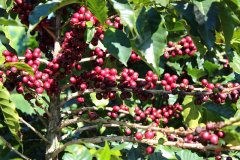The history of Costa Rican coffee only grows Arabica coffee beans? Traditional coffee extraction method
iPura Vida! This is Costa Rica's tourism motto and national slogan, translated as Enjoy Life. Anyone who's been there will tell you that there's no better way to enjoy life than with a cup of freshly roasted Costa Rican coffee between visiting the country's lush jungles and stunning beaches.
Costa Rica is located in Central America (between Panama and Nicaragua) and has a mild climate. Combined with the hilly terrain of the country and the rainy season, the climate provides ideal conditions for growing healthy coffee plants and producing quality coffee beans. Many Costa Rican coffees have intense aromas, excellent taste and flavors that will definitely excite your taste buds. So why is Tico coffee so good? This is a brief history of Costa Rica's coffee industry. The excellent quality and rich flavor of Costa Rican coffee is no accident. Both take time and a lot of effort to achieve (rich flavor and unmatched quality).

As early as 1779, the first coffee beans arrived in Costa Rica from Martinique. Due to its mountainous terrain and tropical climate, coffee fared very well in Costa Rica, quickly becoming one of the country's largest and most important exports.
By 1829, coffee brought in more revenue than sugar, tobacco, and cocoa. To encourage production, the Government provided free land to coffee farmers. At the time, Britain was the largest consumer of Costa Rican coffee. This trend continued until World War II and eventually entered the global market.
Coffee is an important export product of Costa Rica and legislation is therefore enacted to ensure its quality. In 1989, the government passed a law banning the cultivation and production of Robusta coffee because of its poor quality. Soon after, farmers voluntarily stopped producing Catimores coffee because it was also of low quality. The government's ban on second-rate coffee beans has eased slightly. Farmers, however, remain committed to growing Arabica beans where coffee is grown almost everywhere.
Although Costa Rica is not the largest coffee producer in the world, it is arguably the best coffee bean in the world. This is why multinational companies such as Starbucks are opening coffee plantations in Costa Rica. That said, every time you walk into Starbucks (or any other coffee shop), there's a good chance you'll be tasting some Costa Rican delicacy.
Costa Rican coffee brewing tradition
While Costa Rican coffee is available in a variety of brewing methods, from espresso to cold brew, chorreador is favored by locals. It is a variant of the dumping device, nothing more than a wooden filter holder that works with most paper filters. You fold it up and put it in the opening, pour the coffee powder, put the cup under the filter, and pour hot water over it. Chorreador produces a mellow, smooth beer that complements local beans. Antique coffee machine at the Costa Rican museum. Also known as chorreador de cafe. Photos are below:
The trick to using this coffee maker is measuring correctly. Be sure to use a tablespoon of ground coffee and about 4 ounces of hot water. The chorreador comes with a wooden stand that can also hold coffee cups and a filter cloth for brewing coffee. Simply put coffee beans into a filter cloth and pour hot water to make coffee. Once the coffee drips off the filter cloth, it's ready to drink.

The beauty of Costa Rican coffee beans is that they are very rich. You can do anything with them and use any machine and the coffee is still great. That said, it is best to use filter brewing (e.g. pouring) to make a lighter roast to emphasize the slightly sour taste of coffee.
On the other hand, if your Costa Rica coffee is medium or dark roast, use automatic dripper or French press for body balance. Whether you drink coffee alone or latte, your medium coffee will taste sweet.
Important Notice :
前街咖啡 FrontStreet Coffee has moved to new addredd:
FrontStreet Coffee Address: 315,Donghua East Road,GuangZhou
Tel:020 38364473
- Prev

History of Costa Rican Coffee Development characteristics of hand-brewed beans in Mozart Coffee treated with raisin Honey
History of Costa Rican Coffee when you hear about Costa Rican coffee, you may think of coffee of good quality and rich flavor. Both ideas are correct, but this reputation is no coincidence. Costa Ricans attach great importance to their coffee and are proud of what we call golden beans. In 1720, the first batch
- Next

Costa Rican Coffee experience Plantation Tour Costa Rica has four advantages in growing coffee beans
Want to know why coffee lovers and lovers from all over the world go to Costa Rica to enjoy delicious food? Well, because he is one of the best coffee in the world, here are four reasons: tropical high-altitude high-quality Arabica coffee beans Costa Rican coffee experience tropical climate more than 70% of Costa Rican coffee plantations are located in the mountains of the country; as we all know, Goss
Related
- Detailed explanation of Jadeite planting Land in Panamanian Jadeite Manor introduction to the grading system of Jadeite competitive bidding, Red bid, Green bid and Rose Summer
- Story of Coffee planting in Brenka region of Costa Rica Stonehenge Manor anaerobic heavy honey treatment of flavor mouth
- What's on the barrel of Blue Mountain Coffee beans?
- Can American coffee also pull flowers? How to use hot American style to pull out a good-looking pattern?
- Can you make a cold extract with coffee beans? What is the right proportion for cold-extracted coffee formula?
- Indonesian PWN Gold Mandrine Coffee Origin Features Flavor How to Chong? Mandolin coffee is American.
- A brief introduction to the flavor characteristics of Brazilian yellow bourbon coffee beans
- What is the effect of different water quality on the flavor of cold-extracted coffee? What kind of water is best for brewing coffee?
- Why do you think of Rose Summer whenever you mention Panamanian coffee?
- Introduction to the characteristics of authentic blue mountain coffee bean producing areas? What is the CIB Coffee Authority in Jamaica?

